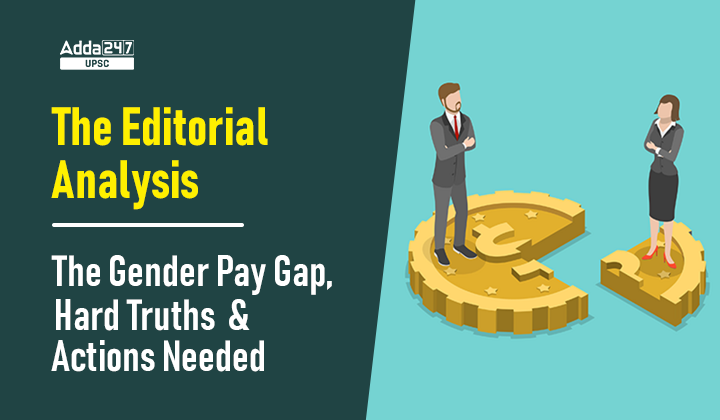Table of Contents
The Gender Pay Gap, Hard Truths and Actions Needed- Relevance for UPSC Exam
- GS Paper 2: Governance, Administration and Challenges
- Government policies and interventions for development in various sectors and issues arising out of their design and implementation.
Gender Pay Gap in News
- Recently, people around the world celebrated the third International Equal Pay Day 2022.
- International Equal Pay Day 2022 falls on September 18, each year.
- In a country the size and diversity of India, asymmetries still abound in the country’s labour market.
Women Transforming India Awards (WTI)
Impact of COVID-19 Pandemic on Gender Pay Gap
- Covid-19 pandemic had a very disproportionate impact on women workers in terms of job and income losses.
- While the full impact of the pandemic is yet to be known, it is clear that its impact has been uneven, with women being among the worst affected in terms of their income security.
- This is partly due to their representation in sectors hard hit by COVID-19, combined with the gendered division of family responsibilities.
- Many women reverted to full-time care of children and the elderly during the pandemic, foregoing their livelihoods to do so.
- ILO’s “Global Wage Report 2020–21”: It suggests the crisis inflicted massive downward pressure on wages and disproportionately affected women’s total wages compared to men.
- This greater wage reduction for women means that the pre-existing gender pay gap has widened.
Gender Pay Gap in India
- Despite notable progress in closing the gender pay gap over time in India, the gap remains high by international standards.
- Indian women earned, on an average, 48% less compared to their male counterparts in 1993-94.
- Since then, the gap declined to 28% in 2018-19 as in the labour force survey data of the National Sample Survey Office (NSSO).
- The pandemic reversed decades of progress as preliminary estimates from the Periodic Labour Force Survey (PLFS) 2020-21 show an increase in the gap by 7% between 2018-19 and 2020-21.
- The data further suggests that faster decline in female wages during the pandemic contributed to this decline, compared to a faster growth in male wages, which requires urgent policy attention.
Causes for Gender Pay Gap
- Common Causes: While individual characteristics such as education, skills or experience explain part of the gender pay gap, a large part of the gender pay gap can still be attributed purely to discrimination based on one’s gender or sex.
- Gender-based discriminatory practices include:
- Lower wages paid to women for work of equal value;
- Undervaluation of women’s work in highly feminised occupations and enterprises, and
- Motherhood pay gap — lower wages for mothers compared to non-mothers.
International Efforts to Close Gender Pay Gap
- At the international level, the United Nations has put the challenge of closing various forms of gender inequality at the heart of its actions.
- The ILO has enshrined ‘equal pay for work of equal value’ in its Constitution and the Convention on the Elimination of All Forms of Discrimination against Women (CEDAW).
- CEDAW provides an international legal framework for realising gender equality and addressing the intersecting forms of discrimination and vulnerabilities among women and girls.
- UN Sustainable Development Goal 8 is “achieving full and productive employment and decent work for all women and men, including for young people and persons with disabilities and equal pay for work of equal value” by 2030.
- In support of SDG 8, the Equal Pay International Coalition (EPIC), was launched in 2017 as a multi-stakeholder initiative led by the ILO, UN Women and the OECD that seeks to achieve equal pay for women and men everywhere.
Steps Taken by India to Close Gender Pay Gap
- Legal Measures: India was one of the pioneering countries to enact the Minimum Wages Act in 1948 and followed by the adoption of the Equal Remuneration Act in 1976.
- In 2019, India carried out comprehensive reforms in both the legislation and enacted the Code on Wages.
- Role MGNREGA Scheme: Evidence shows that the Mahatma Gandhi National Rural Employment Guarantee Act (MGNREGA) in 2005 benefited rural women workers and helped reduce the gender pay gap, both directly and indirectly.
- Directly, by raising the pay levels of women workers who participated in the programme, and
- Indirectly, benefits accrued to women involved in agricultural occupations through higher earnings, as MGNREGA contributed to the rapid rise in overall rural and agricultural wages in the country.
- Maternity Benefit (amendment) Act of 2017: It increased the ‘maternity leave with pay protection’ from 12 weeks to 26 weeks for all women working in establishments employing 10 or more workers.
- This is expected to reduce the motherhood pay gap among mothers in the median and high-end wage earners working in the formal economy.
- Skill India Mission: efforts are being made through the Skill India Mission to equip women with market-relevant skills to bridge the learning-to-livelihood gap and the gender pay gap.
Conclusion
- Equal pay for work of equal value is necessary to close the gender pay gap. Closing the gender pay gap is key to achieving social justice for working women, as well as economic growth for the nation as a whole.
World Employment and Social Outlook 2022




 TSPSC Group 1 Question Paper 2024, Downl...
TSPSC Group 1 Question Paper 2024, Downl...
 TSPSC Group 1 Answer key 2024 Out, Downl...
TSPSC Group 1 Answer key 2024 Out, Downl...
 UPSC Prelims 2024 Question Paper, Downlo...
UPSC Prelims 2024 Question Paper, Downlo...





